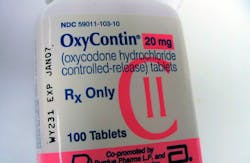The U.S. Food and Drug Administration (FDA) is considering measures to make prescription drugs more difficult to access in a move to prevent overdoses associated with painkillers like OxyContin and Opana, which killed 16,000 people in 2010 alone.
In addition, the FDA is set to increase its role on the painkiller market. So far, the administration has only been responsible for approving new drugs and has not been involved in how the drugs are being used. However, this is about to change as the FDA is serious in its intention to make painkillers safer and harder to access, according to Dan Carpenter, professor at Harvard University.
In order to tackle the problem, the food and drug watchdog is challenging pharmaceutical companies to come up with a safer painkiller that will be harder to abuse. It is planning to implement new regulations that require more demanding independent testing, as well as brand new formulations that can make drugs impossible to crush into powder. The number of people getting addicted to painkillers, both prescribed and illegally obtained, is increasing and this makes the interference of the FDA necessary, the administration said.
According to IHS healthcare group analyst Gustav Ando, companies will be tempted to accept the challenge because the rewards may be huge for those who manage to produce a new, safer painkiller. If the national regulator approves the drug and labels it as effectively reducing abuse, this will lead to more prescriptions and potentially large profit. Pharma companies tend to flock where the big money is and developing a next-generation painkiller could be a cash cow for the business, he added.
At the moment, the most common painkillers available on the market are generic. The company that manages to come up with what the FDA is looking for will certainly grab a significant market share, experts comment. It will be a situation in which huge companies will actually perform better, despite the tighter regulation, Carpenter believes.
However, the idea also has its opponents. According to Philadelphia-based doctor Aviva Fohrer, who works with drug addicts, making access to painkillers more difficult could push many people to cheaper and more dangerous alternatives, like heroin. Since it is illegal, there is no way to know who made it and what its ingredients are, making its use far more risky than legally manufactured and regulated painkillers, she warned.
Meanwhile, it has emerged that the FDA has plans to introduce tougher restrictions on the use of hydrocodone, which is commonly found in prescription drugs such as Vicodin, Norco and Lortab. The substance is among the most widely prescribed in the United States, with 131 million prescriptions written in 2010. If the proposed restrictions get the go-ahead, hydrocodone will be treated in the same way as oxycodone, morphine and methadone. This means that specific safe doses that can be taken between visits to the doctor will be introduced.
